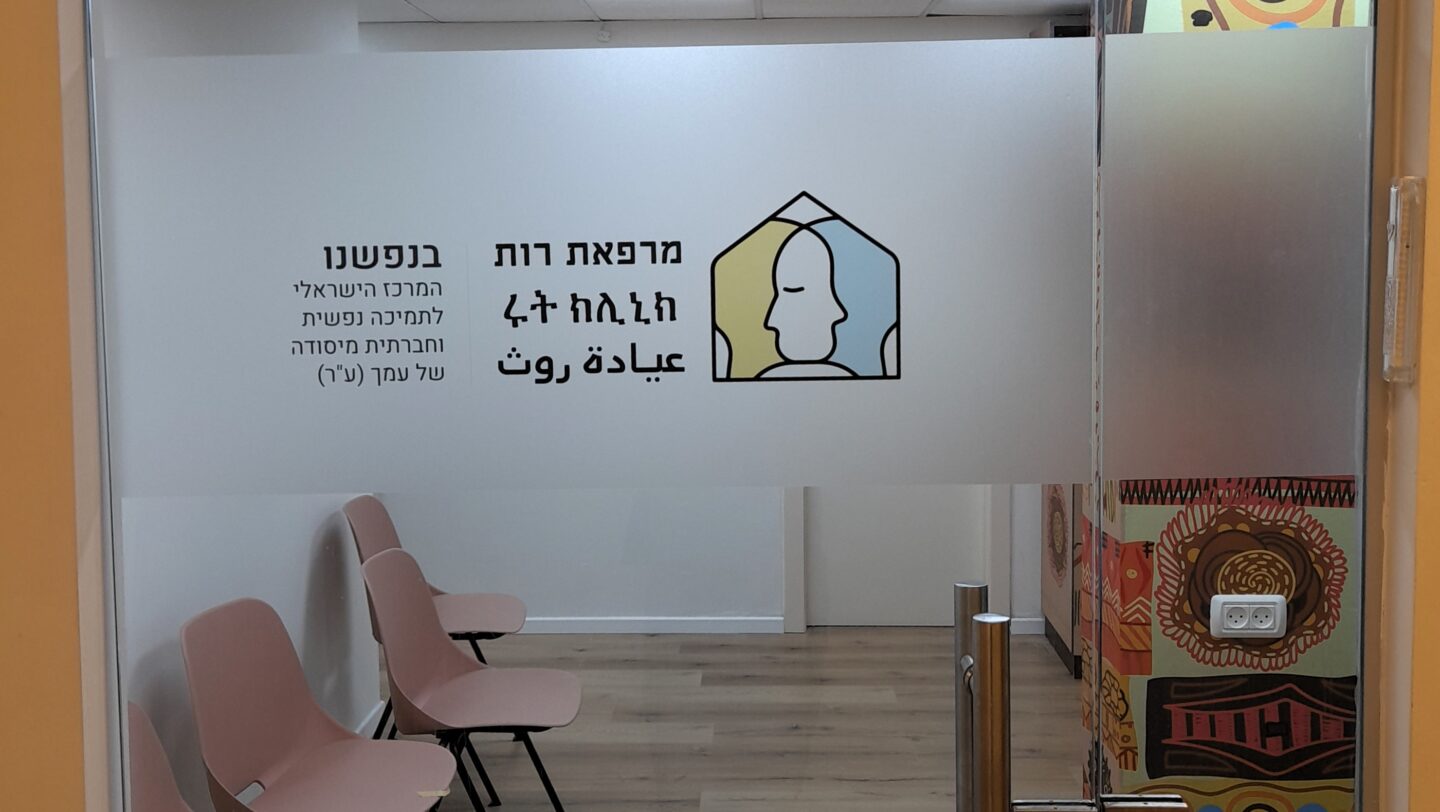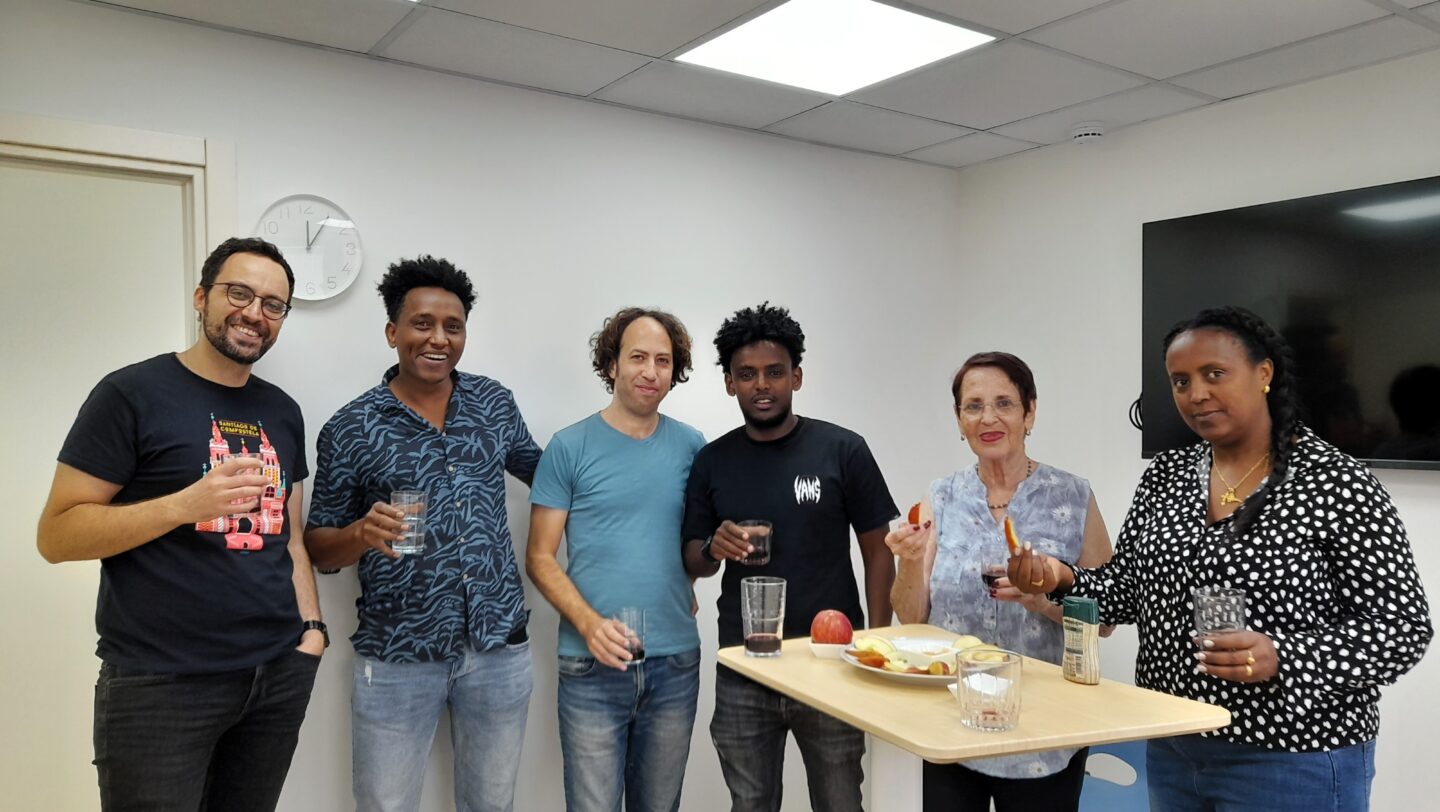Pioneer in mental health treatment for asylum-seekers, Ruth (former Gesher) Clinic bids farewell to their community as transition into a new chapter begins.
** Trigger Warning: Violence

The Ruth clinic reception in Tel-Aviv, on its last days of service, November 2023. Photo: Ruth Clinic.
As Hava Kreisler recalls her dozens of patients at Ruth Clinic, she concludes: “If it wasn’t for the traumas they underwent in their country, on their journey to Israel, and also in Israel, most of this population would not have needed mental health treatment.”
She lists symptoms such as: difficulty sleeping, memory difficulties, interruption of the continuum of experience. A very large loss of trust in people, difficulty functioning, great fear, increased alertness, apathy. “These are very clear symptoms of PTSD for those who have gone through near-death experiences or witnessed events such as murder, torture.”
Today, this account echoes what many mental health experts in Israel are dealing with on an unprecedented scale following the 7 October terror-attack, but for Hava has been helping African refugees dealing with war or torture related to PTSD for a decade. These are symptoms she treated as a senior clinical psychologist at the Ruth Clinic (and formally Gesher clinic), a mental health clinic for asylum-seekers.
In the years preceding the founding of the Gesher Clinic, some 50,000 people arrived in Israel through the Egyptian border, even if some reached this destination unintentionally. Tens of thousands of Sudanese and Eritreans fled war and were kidnapped on the Sudan-Egypt border. For months, thousands of them were subjected to severe torture and constant threat. Many testimonies have reached UNHCR, Physicians for Human Rights and other organizations, among them, the therapists in Gesher. Asylum seekers recount being chained with iron shackles, extreme violence, rape and other intimidations. They revealed burns on their bodies and were forced to witness the murder of their friends and relatives. Lastly, they dealt with the fear and anxiety of collecting a ransom fee of $35,000 or more, in exchange for their release at the Israeli border.
These people came to seek refuge in a new country, in a foreign culture and language, and began a new chapter full of anguish and uncertainty.
A study conducted in 2017 at the University of Haifa in cooperation with Physicians for Human Rights found that more than ten percent of the approximately 37,000 asylum seekers living in Israel at that time, some 4,000 people, were victims of sever torture as a result of what was later referred to as “Sinai torture camps”. About a quarter of the victims suffer from anxiety and depression, no less than 76% of men and 60% of women suffer from PTSD. However, as asylum-seekers are not citizens, they are not members of the public health system, and those who work have health insurance which does not include mental health treatment.
Thus, in February 2014, once details of Sinai and its traumatic effects on asylum-seekers’ mental health were disclosed on a large scale, a joint initiative by UNHCR and the Ministry of Health, established the Gesher Clinic at the Jaffa Community Center for Mental Health. In 2019, after four years of activity, the Gesher Clinic closed, due to budgetary and organizational considerations. Gesher clinic staff who witnessed the huge need among their patients, was relieved once the “Amcha-Bnefeshnu” organization won the bid to operate the new clinic, Ruth. At the initiative of Dr. Martin Auerbach, the clinical director of the association, “Amcha-Benfeshnu” operated the unique clinic for 4 years in which psychiatric treatments, psychotherapies, group therapy and a socio-therapeutic space including yoga therapy and more. In these four years, the clinic welcomed more than 800 patients with 12 staff members (2 psychiatrists, 3 psychologists including director, 2 psychotherapists, 1 social worker, 1 psychiatric nurse, 3 interpreters-mediators) unable to meet the acceding need and long waiting lists in just three days of work each week.
“Mental health care is not like orthopedic care, you can’t change a therapist on a dime… it takes time to build trust and relationships”
“The Ruth Clinic was part of the Amcha – Benafshenu organization (who aids holocaust survivors, D.R) and it was only natural for us to treat people who have undergone man-made horrors,” says Gil Carmeli, psychologist, and director of the Ruth Clinic
The Ruth Clinic long journey ended on 29 November 2023. The patients, and some of the staff are slowly transitioning to the new clinic, established by the Ministry of Health and will operate at Ichilov Hospital in Tel Aviv. Although the move to include asylum-seekers in government infrastructure is a step in the right direction, the change of the staff and the relocation of patients to a new clinic is accompanied by mixed feelings.
Gil is pleased to see some of the Ruth clinic staff at Ichilov; social worker and mediators who were at the core of the Ruth will be there to assist with the sensitive issues of the community. “Mental health care is not like orthopedic care, you can’t change a therapist on a dime… it takes time to build trust and relationships, people have brought the most intimate things to this building.”

Ruth clinic staff at a Rosh Hashana toast: Aster Nuguse, Hava Kreisler, Bhalibi Tsegezab, Gil Carmeli, Hadera Zerei, Yuval Klap
Kibrom Tewelde Gebremariam, Director at the Hotline for Refugees and Migrants, and leader of New Hope for Eritrea (a community organization of Eritrean asylum-seekers), started as a cultural mediator at Gesher and later the Ruth clinic from 2017-2022. The western psychology method was new to him as well as to the patients, but the mediator role as a key part of therapy was new to the Israeli staff. “Using a third party as a translator, mediator, and putting your trust in them to convey your message is very challenging, it required developing this skill from the therapists.”
Hava echoed Kibrom’s words: “We know Western psychology, but we don’t know their world and their culture.” But it wasn’t only skills she had to develop, in order for this to work. “As a therapist, it required me to have a lot of trust in the interpreter, who the patient was actually talking to directly.” Trust is the key word in the Ruth Clinic, and the trust that the patient places in the therapist passes through the mediator-translator, who is part of the community, and sometimes even a neighbor.
Hadera Zerei has been working at the Ruth Clinic for over two years as a translator and cultural mediator. Hadara came to Israel from Eritrea in 2009, and began working as a mediator at the end of 2021. Mediation between therapist and patient has been much more than just a job for him. “While helping people, I understood things about myself, about what I went through along the way.”
Kibrom sheds light on the gap between the two cultures. perceptions of mental health. “In Eritrea, when there are mental-health difficulties, we usually give them recognition only when people collapse or experience a psychotic outbreak. The intervention in Eritrea will be through religious or cultural rituals.”
Being a mediator is not about translating the therapist’s words or professional terms in a literal matter, you are a more of a cultural commentator, explained Kibrom on this unusual and essential role. One example he shared is, that even for the most simple question: How are you? There could be various interpretations and layers. “Patients will reply ‘OK,’ during their most difficult hours,” Kibrom says. “You’re translating ‘OK’ within a cultural context, because you know there are other layers to this answer. You see the movements and gestures, the facial expressions, you know it’s ‘OK’ said with pain, or at other times a polite ‘OK’. You translate this short word as a fuller picture to the therapist, and when the therapist understands, they will answer—Fine, and now let’s talk about what’s not OK.”
With his work at the clinic, Kibrom, like other mediators, had another role. They became mediators between the “system” – the Western entity – and members of their community, who come from a traditional culture, when it came to any medical care. “People’s trust in the system has been severely broken, and it’s hard for our community to accept a doctor’s prescription for example for an injection, or an antidepressant medication.” He explained. “The mediator needs to create trust between the therapists and the patient, I often had to get in a word or sentence that explains to people that it is okay to follow the doctor’s recommendation.”
Thus, on the shoulders of Hadara and the other mediators and translators rests a heavy responsibility both within the walls of the clinic and outside it. Kibrom and Hadera saw firsthand their fellow community members get better with psychotherapy treatment. Both mentioned the clinic team’s dedication as motivation for overcoming their personal challenges, the memories of their personal experiences, and the toll the work took on them. “I haven’t attended a community event since 2017, because I know I’m going to run into patients, and I don’t want to put them in that situation,” said Kibrom. He knows that the price of social ostracism or humiliation to a member of the community (due to cultural stigma for being treated for mental health) is higher than staying at home.
You gave me back the belief that people can be good, and that I can have a future
The practice of cultural mediators, as well as phone notice ahead of an appointment, are another bridge that builds trust between patients and the staff, according to Hava. “If someone doesn’t show up, we call to follow up, and many times patients are surprised someone was waiting for them, that we care if they show up or not, that they matter to someone. After all the abuse they’ve been through, it’s a basis for contact.”
One example is the story of her patient, Tesfay (an alias). An Eritrean man in his 30s, who came to the clinic in state of great distress, with depression that made it impossible for him to work. In most of the meetings he hardly spoke, until one day he stopped coming to the clinic altogether, and did not answer his phone.
“I was looking all over for him and after a while, I managed to locate him, and learned that he had lost his phone,” says Hava. “I told him we worried about him and how happy I was to hear his voice. From that day on, he didn’t miss a single meeting.” When he returned to the clinic, Tesfay began to share his traumatic experiences in Sinai, how his friends were murdered before his eyes, and the physical torture he had undergone. Gradually, he shed his coat and hat, which he wore all year round, and later he got a part-time job until he left for Canada and enrolled in school. “He would call me on Sunday at 4 p.m. local time, which is our session time.” Hava recalls Tesfays goodbye words to this day: “People can give you a million dollars, but it it’s not real help. You gave me back the belief that people can be good, and I can have a future.”
Share on Facebook Share on Twitter